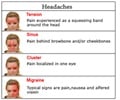People with migraine are more likely to have higher concentrations of sodium in cerebrospinal fluid than people without migraine.
Highlights:
- Higher concentrations of sodium in cerebrospinal fluid can help diagnose a migraine
- Cerebral sodium MRI can be used as a technique help in the diagnosis and understanding of migraines
- Migraine affects about 18 percent of women and 6 percent of men.
Cerebral Sodium MRI
The research team explored a magnetic resonance technique called cerebral sodium MRI to diagnose and understand migraine attacks. Studies have shown that sodium plays an important role in the brain chemistry.The team recruited 12 women with a mean age of 34, who had been clinically evaluated for migraine. The participants filled out a questionnaire on migraine regarding its length, intensity, frequency and accompanying auras. The study also involved a control group of 12 healthy women of similar age.
Participants in both the groups underwent cerebral sodium MRI. The team analyzed the sodium concentrations of migraine patients and healthy controls. There were no statistical differences between the two groups for sodium concentrations in the gray and white matter, brain stem, and cerebellum. However, they found a significant difference in sodium concentrations in the cerebrospinal fluid (fluid that surrounds the brain and spinal cord). Cerebrospinal fluid act as a cushion for the brain and also ensures chemical stability for proper brain function.
The findings of the study might facilitate the challenging diagnosis of a migraine. The research team hopes to conduct future studies to learn more about the link between migraines and higher sodium concentration.
"As this was an exploratory study, we plan to examine more patients, preferably during or shortly after a migraine attack, for further validation," said Dr Meyer.
The findings of the study were presented at the annual meeting of the Radiological Society of North America (RSNA).
Migraine
A migraine is one of the most common headache disorders, headache disorders that can cause severe throbbing pain, usually on one side of the head. The condition is accompanied by nausea, vomiting, vision changes and extreme sensitivity to light and sound.Diagnosis of a migraine is challenging because the characteristics of migraines and the types of attacks vary widely among patients. Most of the patients with migraine are undiagnosed and untreated. But, in contrast, some patients are treated with migraine medications even though they suffer from a different type of a headache.
The symptoms of a migraine may vary from person to person and the attacks differ in length and frequency.
Common Triggers of A migraine
Some of the common triggers of a migraine are hormonal changes, stress, depression, anxiety, medications, lack of sleep, alcohol, loud noises, second-hand smoke, and bright lights. Diet-related triggers for a migraine are caffeine, chocolate, cheese, citrus fruits, and processed foods that contain the additive tyramine.Facts on Migraine
- Migraine affects about 18 percent of women and 6 percent of men
- A migraine attack may last from four to 72 hours
- Migraine can have an impact on work, family and social lives
- About 70 to 90% of the people experience migraine without aura
- Migraine with aura is common which has additional neurological symptoms
- A headache for more than 15 days could be a chronic migraine
- Migraine with brainstem aura is a rare subtype
- A hemiplegic migraine involves temporary weakness on one side of the body
- Abdominal migraine is often seen in children.
Reference:
- About Migraine - (https://www.migrainetrust.org/about-migraine/migraine-what-is-it/more-than-just-a-headache/)
Source-Medindia
















